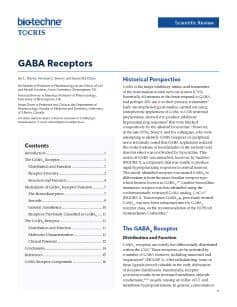GABAB Receptors
GABAB receptors are metabotropic G-protein-coupled receptors (GPCRs) responsible for mediating the inhibitory effects of GABA, alongside ionotropic GABAA and GABAA-ρ receptors. They exist as heterodimers of GABAB1 and GABAB2 subunits, and are located on both pre- and post-synaptic membranes.
GABAB Receptor Agonists |
|
|---|---|
| Cat. No. | Product Name / Activity |
| 0796 | (R)-Baclofen |
| Selective GABAB agonist; active enantiomer of (RS)-Baclofen (Cat. No. 0417) | |
| 0417 | (RS)-Baclofen |
| Selective GABAB agonist | |
| 0344 | GABA |
| Endogenous agonist | |
| 3400 | RuBi-GABA |
| Caged GABA; excitable at visible wavelengths | |
| 4709 | RuBi GABA trimethylphosphine |
| Caged GABA; inhibits neural activity | |
| 0379 | SKF 97541 |
| Highly potent GABAB agonist; also GABAA-ρ antagonist | |
GABAB Receptor Antagonists |
|
| Cat. No. | Product Name / Activity |
| 1245 | CGP 35348 |
| Selective GABAB antagonist; brain penetrant | |
| 3219 | CGP 36216 hydrochloride |
| GABAB antagonist; displays activity at presynaptic receptors | |
| 1246 | CGP 52432 |
| Potent and selective GABAB antagonist | |
| 1088 | CGP 54626 hydrochloride |
| Potent and selective GABAB antagonist | |
| 1248 | CGP 55845 hydrochloride |
| Potent and selective GABAB antagonist | |
| 0245 | 2-Hydroxysaclofen |
| Selective GABAB antagonist; more potent than Saclofen (Cat. No. 0246) | |
| 0246 | Saclofen |
| Selective GABAB antagonist | |
| 0984 | SCH 50911 |
| Selective and competitive GABAB antagonist; orally bioavailable | |
GABAB Receptor Modulators |
|
| Cat. No. | Product Name / Activity |
| 3313 | rac BHFF |
| Potent and selective postitive allosteric modulator of GABAB receptors | |
| 1513 | CGP 7930 |
| Positive allosteric modulator of GABAB receptors | |
| 2001 | GS 39783 |
| Positive allosteric modulator of GABAB receptors | |
Other |
|
| Cat. No. | Product Name / Activity |
| 1811 | Modafinil |
| Psychostimulant | |
| 2687 | Pentylenetetrazole |
| CNS stimulant | |
| 2815 | Valproic acid, sodium salt |
| Increases GABA levels; anticonvulsant | |
| 2625 | Zonisamide |
| Modulates GABA neurotransmission; anticonvulsant | |
GABAB receptors are GPCRs composed of seven transmembrane domains and a large extracellular N-terminal, and are responsible for mediating the inhibitory effects of GABA, alongside ionotropic GABAA and GABAA-ρ receptors. They are composed of 850 - 960 amino acids, and are most similar in structure to metabotropic glutamate receptors (mGluRs).
These receptors are heterodimers of GABAB1 and GABAB2 subunits. The GABAB1 subunit hosts the binding site for GABA and other ligands, while the GABAB2 subunit couples to Gi/o signaling proteins. The two subunits interact allosterically: GABAB1 increases coupling of GABAB2 to G proteins and GABAB2 increases agonist binding to GABAB1. Through their Gi/o coupling, GABAB receptors activate postsynaptic inward rectifier K+ channels (KIR channels; GIRK), decrease calcium conductance and inhibit adenylyl cyclase.

GABAB receptors are widely distributed within the central nervous system, and are found on pre- and post-synaptic membranes, but show low density. The highest concentrations are found in the cerebellum, frontal cortex and specific thalamic nuclei. They are also found on autonomic nerves in the periphery.
On the presynaptic membrane GABAB receptors inhibit neurotransmitter release, including acting as autoreceptors to regulate the release of GABA. When located on excitatory presynaptic terminals, they regulate glutamate release. These actions occur via the inhibition of Ca2+ channels, mediated by the G-protein β/γ subunits, and subsequent decrease in Ca2+ influx in response to an arriving action potential. Postsynaptic GABAB receptors mediate slow, inhibitory synaptic transmission, through the activation of KIR channels that mediate the late phase of the inhibitory postsynaptic potential.
Baclofen, a GABA derivative and GABAB agonist, is the only widely clinically available drug targeting the GABAB receptor. It was originally developed as a treatment of epilepsy, but showed disappointing results. It is now primarily used to treat spastic movement associated with multiple sclerosis and cerebral palsy. Baclofen has also been studied for the treatment of alcohol addiction. Similarly, activation of the GABAB receptor, with an agonist or a positive allosteric modulator, is thought to reduce the craving for addictive drugs, such as cocaine.
External sources of pharmacological information for GABAB Receptors :
Literature for GABAB Receptors
Tocris offers the following scientific literature for GABAB Receptors to showcase our products. We invite you to request* your copy today!
*Please note that Tocris will only send literature to established scientific business / institute addresses.
GABA Receptors Scientific Review
Written by Ian Martin, Norman Bowery and Susan Dunn, this review provides a history of the GABA receptor, as well as discussing the structure and function of the various subtypes and the clinical potential of receptor modulators; compounds available from Tocris are listed.
Addiction Poster
The key feature of drug addiction is the inability to stop using a drug despite clear evidence of harm. This poster describes the brain circuits associated with addiction, and provides an overview of the main classes of addictive drugs and the neurotransmitter systems that they target.

